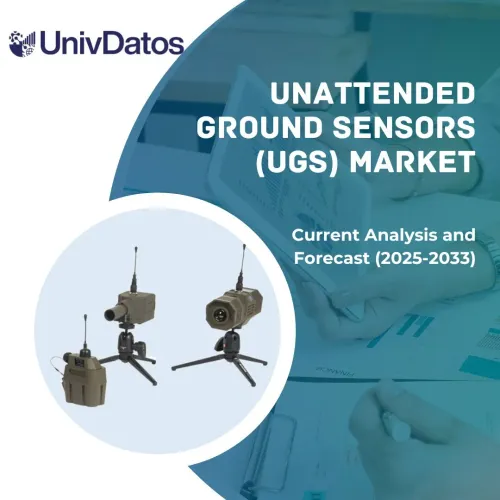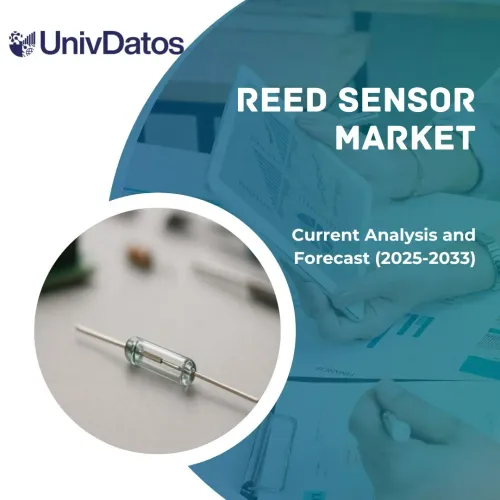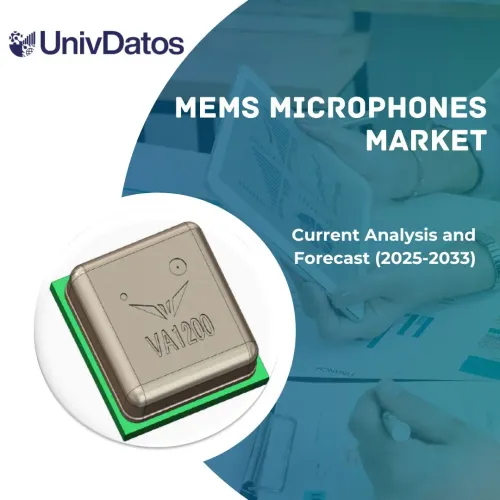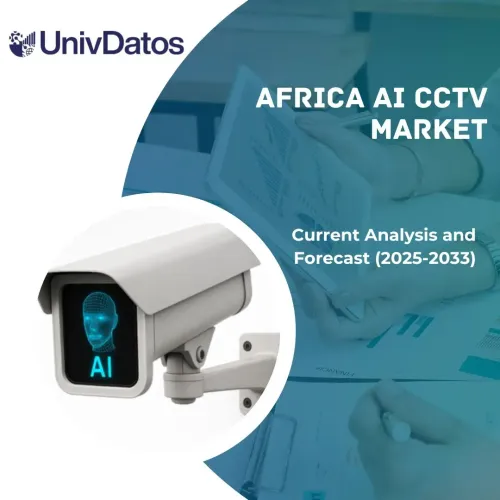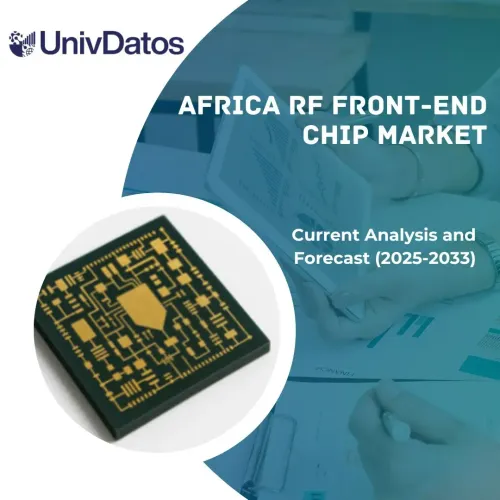- Home
- Chi siamo
- Settore
- Servizi
- Lettura
- Contattaci
Mercato dei sensori TOF per imaging 3D: analisi attuale e previsioni (2024-2032)
Enfasi sul Tipo di Prodotto (Sensori ToF Diretti e Sensori ToF Indiretti), Applicazione (Riconoscimento Gesti, Scansione e Imaging 3D, Realtà Aumentata e Realtà Virtuale, Sicurezza e Navigazione Automobilistica, Automazione Industriale e Robotica e Altro), Settore Verticale (Elettronica di Consumo, Automobilistico, Industriale e Altro); e Regione/Paese
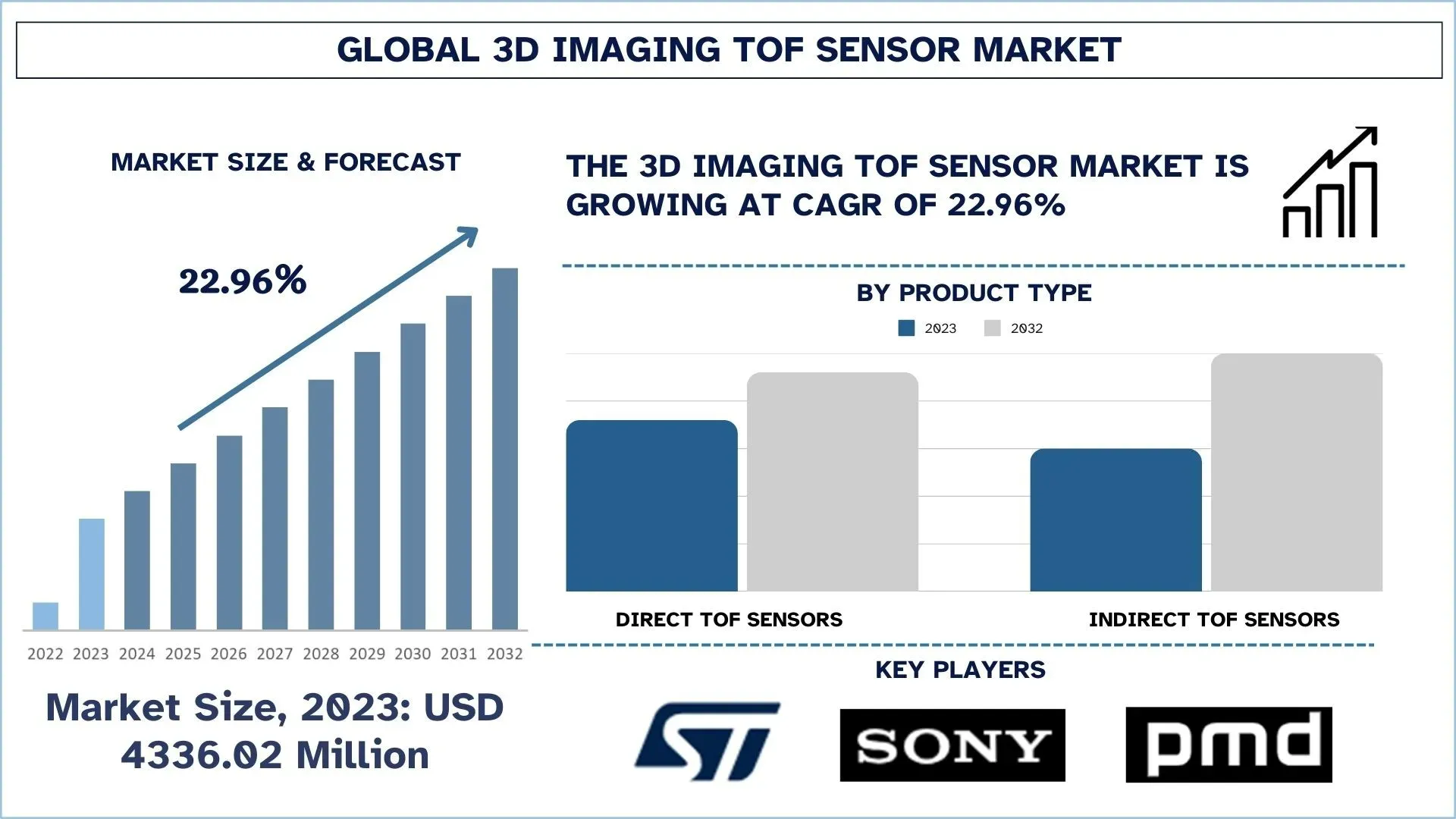
Dimensioni e previsioni del mercato dei sensori TOF per l'imaging 3D
Il mercato dei sensori TOF per l'imaging 3D è stato valutato a circa 4336,02 milioni di dollari nel 2023 e si prevede che crescerà a un sostanziale CAGR di circa il 22,96% durante il periodo di previsione (2024-2032), grazie al potenziale vantaggio della tecnologia ToF per il rilevamento preciso della profondità e il rilevamento degli oggetti.
Analisi del mercato dei sensori TOF per l'imaging 3D
Il time of flight (ToF) 3D è un tipo di LIDAR (light detection and ranging) senza scanner che utilizza impulsi ottici ad alta potenza della durata di nanosecondi per acquisire informazioni sulla profondità (in genere su brevi distanze) da una scena di interesse. La relativa tecnologia 3D indirect time of flight (iToF) è un sistema di imaging della profondità che utilizza un array di pixel per acquisire informazioni sulla profondità da una scena di interesse che è stata illuminata da una luce laser a onda continua modulata ad alta potenza fissa.
Il sensore ToF per l'imaging 3D è anche chiamato sensore Time-of-Flight per l'imaging 3D ed è applicato in diversi settori esistenti ed emergenti per fornire un'elevata precisione nella sensibilità alla profondità e nella competenza di imaging 3D accurata e in tempo reale. Nel settore dell'elettronica di consumo, i sensori ToF migliorano il riconoscimento facciale, la realtà aumentata, la realtà virtuale e le applicazioni di fotografia per smartphone, il che li rende cruciali nella prossima generazione di gadget tecnologici. L'automotive è un altro importante segmento di applicazione, in cui i sensori ToF hanno un'ampia applicazione in ADAS, navigazione autonoma e LiDAR. Inoltre, le applicazioni di automazione industriale e robotica hanno iniziato ad adottare sensori ToF per il rilevamento di oggetti, la gestione dell'inventario e il monitoraggio della qualità del prodotto. Altri settori che possono trarre vantaggio dall'imaging 3D sono la diagnostica e la robotica medica nel settore sanitario. Inoltre, le crescenti soluzioni per le città intelligenti, la crescente sorveglianza operativa AI e gli sviluppi nell'IA e nell'edge computing stanno spingendo ulteriormente la domanda.
Tendenze del mercato dei sensori TOF per l'imaging 3D
Questa sezione illustra le principali tendenze del mercato che influenzano i vari segmenti del mercato dei sensori TOF per l'imaging 3D, come identificate dai nostri esperti di ricerca.
Sistemi ToF e LiDAR ibridi
La combinazione di sensori ToF con LiDAR sta gradualmente diventando la tendenza nel mercato attuale per applicazioni come veicoli autonomi, robotica e città intelligenti. I sensori ToF sono altamente accurati nel rilevamento della profondità a corto-medio raggio e nel basso consumo energetico, mentre il LiDAR è coinvolto nella mappatura 3D a lungo raggio e nella scansione ambientale. L'aggiunta e l'integrazione di queste tecnologie rendono possibile l'identificazione di oggetti in tempo reale, il rilevamento di ostacoli e l'imaging 3D ad alta precisione per auto a guida autonoma, robotica industriale e droni. Inoltre, le combinazioni ToF-LiDAR ad alte prestazioni vengono adattate nelle applicazioni geospaziali, nella difesa e nell'uso di AR e VR, che richiedono dati di profondità accurati. I principali produttori di sensori ToF e i giganti tecnologici stanno pianificando e spendendo una grande quantità di denaro per migliorare questo approccio al fine di aumentare l'efficienza dei sensori e la gamma di percezione della profondità e consentire loro di operare in qualsiasi ambiente.

Si prevede che l'Asia-Pacifico sarà la regione in più rapida crescita
Si prevede che l'Asia-Pacifico crescerà al CAGR più elevato durante il periodo di previsione per i sensori ToF per l'imaging 3D a causa della sua grande necessità di mercato nei settori dell'elettronica di consumo e dell'automotive e dell'aumento delle applicazioni nel settore sanitario. Attualmente, paesi come Cina, Giappone e India sono dominanti nella produzione di smartphone, dove i sensori ToF sono impiegati per applicazioni come il riconoscimento facciale, la realtà aumentata e il miglioramento dei sistemi di telecamere dei dispositivi. Inoltre, la crescente penetrazione di auto a guida autonoma e ADAS nella regione sta promuovendo l'integrazione del sensore ToF nel LiDAR e nel rilevamento della profondità in tutto il mercato. Il settore della robotica e dell'automazione industriale in costante aumento, grazie a politiche governative come "Make in India" e "Made in China: 2025", accelera la crescita del mercato. L'aumento degli investimenti nell'imaging sanitario e nella sorveglianza intelligente della catena è un altro fattore che incide sulla crescita del mercato. I produttori di semiconduttori e la crescente integrazione della ricerca e sviluppo in tutta la regione Asia-Pacifico daranno impulso alla crescita del mercato dei sensori ToF per l'imaging 3D nel periodo previsto.
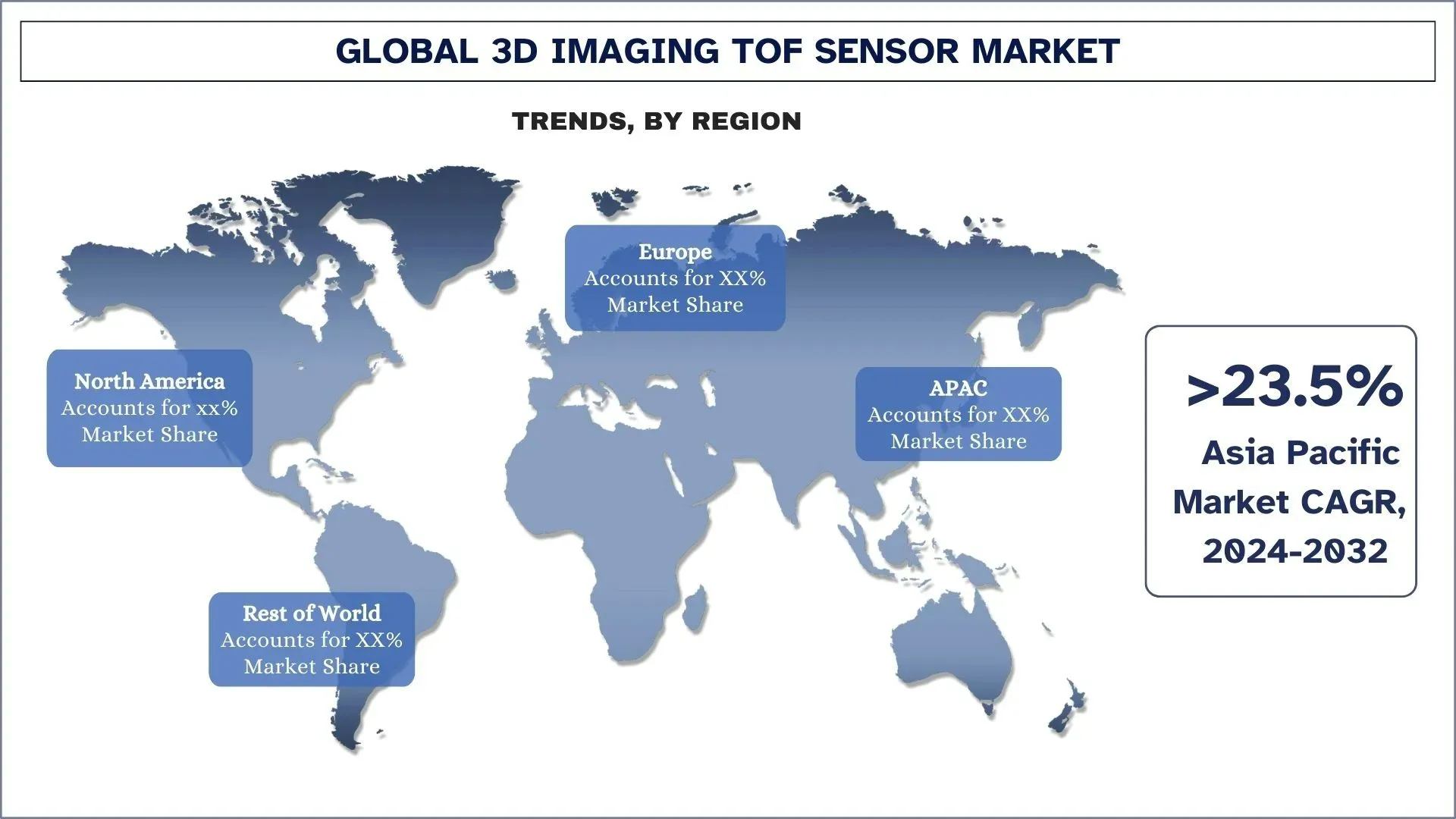
Settore dei sensori TOF per l'imaging 3D Panorama competitivo
Il mercato dei sensori TOF per l'imaging 3D è competitivo, con diversi attori globali e internazionali. I principali attori stanno adottando diverse strategie di crescita per migliorare la loro presenza sul mercato, come partnership, accordi, collaborazioni, nuovi lanci di prodotti, espansioni geografiche e fusioni e acquisizioni.
Principali aziende produttrici di sensori TOF per l'imaging 3D
Alcuni dei principali attori che operano nel mercato sono STMicroelectronics, Sony Semiconductor Solutions Corporation, Pmdtechnologies AG, Infineon Technologies AG, Melexis, ams-OSRAM AG, Texas Instruments Incorporated, Analog Devices, Inc., Teledyne Vision Solutions (Teledyne Technologies), ifm electronic India Pvt. Ltd. (ifm Group).
Notizie sul mercato dei sensori TOF per l'imaging 3D
- A febbraio 2024 – STMicroelectronics si espande nel rilevamento della profondità 3D con i più recenti sensori time-of-flight. ST presenta nuovi sensori Time-of-Flight diretti e indiretti per applicazioni chiave come l'assistenza alla fotocamera, la realtà virtuale, la webcam 3D, la robotica e gli edifici intelligenti. Si prevede che queste espansioni accelereranno la crescita del mercato dei sensori TOF per l'imaging 3D in tutto il mondo.
- A luglio 2024 - Nuvoton Technology Corporation, Japan (NTCJ) ha annunciato l'inizio della produzione di massa di un sensore 3D Time-of-Flight (TOF*1) con risoluzione VGA (640x480 pixel) da 1/4 di pollice. Questo sensore è destinato a rivoluzionare il riconoscimento di persone e oggetti in vari ambienti interni ed esterni. Questa capacità è stata raggiunta grazie all'esclusiva tecnologia di progettazione dei pixel di NTCJ e alla tecnologia di calcolo della distanza/Image Signal Processor (ISP*2).
- A novembre 2024 - TOPPAN Holdings Inc. ha sviluppato il suo sensore ToF (Time of flight) 3D di prima generazione per la robotica nel 2023, utilizzando la tecnologia ibrida ToF™2 per consentire la misurazione a lungo raggio, la tolleranza agli ambienti esterni, il rilevamento ad alta velocità e l'uso simultaneo di più dispositivi. L'azienda ha ora ulteriormente migliorato l'imaging ad alta velocità e la misurazione della distanza ad alta precisione della prima generazione per sviluppare un nuovo modello di sensore ToF 3D con un fattore di forma più compatto e un minore consumo energetico.
Copertura del rapporto sul mercato dei sensori TOF per l'imaging 3D
Dettagli | |
Anno base | 2023 |
Periodo di previsione | 2024-2032 |
Slancio di crescita | Accelerazione a un CAGR del 22,96% |
Dimensione del mercato 2023 | 4336,02 milioni di dollari |
Analisi regionale | Nord America, Europa, Asia-Pacifico, Resto del mondo |
Principale regione contributiva | Si prevede che la regione Asia-Pacifico crescerà al CAGR più elevato durante il periodo previsto. |
Principali paesi coperti | Stati Uniti, Canada, Germania, Francia, Regno Unito, Spagna, Italia, Cina, Giappone e India |
STMicroelectronics, Sony Semiconductor Solutions Corporation, Pmdtechnologies AG, Infineon Technologies AG, Melexis, ams-OSRAM AG, Texas Instruments Incorporated, Analog Devices, Inc., Teledyne Vision Solutions (Teledyne Technologies), ifm electronic India Pvt. Ltd. (ifm Group) | |
Ambito del rapporto | Tendenze di mercato, driver e vincoli; Stima e previsione dei ricavi; Analisi della segmentazione; Analisi della domanda e dell'offerta; Panorama competitivo; Profilazione aziendale |
Segmenti coperti | Per tipo di prodotto, per applicazione, per verticale di settore, per regione/paese |
Motivi per acquistare questo rapporto:
- Lo studio include l'analisi della dimensione del mercato e delle previsioni convalidate da esperti chiave del settore autenticati.
- Il rapporto presenta una rapida panoramica delle prestazioni complessive del settore a colpo d'occhio.
- Il rapporto copre un'analisi approfondita dei principali colleghi del settore con un focus primario sui principali dati finanziari aziendali, portafogli di prodotti, strategie di espansione e sviluppi recenti.
- Esame dettagliato dei driver, dei vincoli, delle tendenze chiave e delle opportunità prevalenti nel settore.
- Lo studio copre in modo completo il mercato attraverso diversi segmenti.
- Analisi approfondita a livello regionale del settore.
Opzioni di personalizzazione:
Il mercato globale dei sensori TOF per l'imaging 3D può essere ulteriormente personalizzato in base alle esigenze o a qualsiasi altro segmento di mercato. Oltre a questo, UMI comprende che potresti avere le tue esigenze aziendali, quindi sentiti libero di connetterti con noi per ottenere un rapporto che si adatti completamente alle tue esigenze.
Indice
Metodologia di ricerca per l'analisi del mercato dei sensori TOF per imaging 3D (2022-2032)
L'analisi del mercato storico, la stima del mercato attuale e la previsione del mercato futuro del mercato globale dei sensori TOF per imaging 3D sono stati i tre passaggi principali intrapresi per creare e analizzare l'applicazione dei sensori TOF per imaging 3D nelle principali regioni a livello globale. È stata condotta un'esaustiva ricerca secondaria per raccogliere i dati di mercato storici e stimare le dimensioni del mercato attuale. In secondo luogo, per convalidare queste intuizioni, sono stati presi in considerazione numerosi risultati e presupposti. Inoltre, sono state condotte interviste primarie esaustive con esperti del settore lungo tutta la catena del valore del mercato globale dei sensori TOF per imaging 3D. Dopo l'assunzione e la convalida dei dati di mercato attraverso interviste primarie, abbiamo impiegato un approccio top-down/bottom-up per prevedere le dimensioni complete del mercato. Successivamente, sono stati adottati metodi di suddivisione del mercato e di triangolazione dei dati per stimare e analizzare le dimensioni del mercato dei segmenti e dei sottosegmenti del settore. La metodologia dettagliata è spiegata di seguito:
Analisi delle dimensioni del mercato storico
Fase 1: Studio approfondito delle fonti secondarie:
È stato condotto uno studio secondario dettagliato per ottenere le dimensioni del mercato storico del mercato dei sensori TOF per imaging 3D attraverso fonti interne all'azienda come relazioni annuali e bilanci, presentazioni sulle performance, comunicati stampa, ecc. e fonti esterne tra cui riviste, notizie e articoli, pubblicazioni governative, pubblicazioni della concorrenza, rapporti di settore, database di terze parti e altre pubblicazioni credibili.
Fase 2: Segmentazione del mercato:
Dopo aver ottenuto le dimensioni del mercato storico del mercato dei sensori TOF per imaging 3D, abbiamo condotto un'analisi secondaria dettagliata per raccogliere informazioni storiche sul mercato e quote per diversi segmenti e sottosegmenti per le principali regioni. I segmenti principali inclusi nel rapporto sono tipo di prodotto, applicazione, settore verticale e regioni. Ulteriori analisi a livello di Paese sono state condotte per valutare l'adozione complessiva dei sensori TOF per imaging 3D in quella regione.
Fase 3: Analisi dei fattori:
Dopo aver acquisito le dimensioni del mercato storico di diversi segmenti e sottosegmenti, abbiamo condotto un'analisi dei fattori dettagliata per stimare le dimensioni del mercato attuale del mercato dei sensori TOF per imaging 3D. Inoltre, abbiamo condotto un'analisi dei fattori utilizzando variabili dipendenti e indipendenti come tipo di prodotto, applicazione, settore verticale e regioni del mercato dei sensori TOF per imaging 3D. È stata condotta un'analisi approfondita degli scenari di domanda e offerta considerando le principali partnership, fusioni e acquisizioni, espansione aziendale e lancio di prodotti nel mercato dei sensori TOF per imaging 3D in tutto il mondo.
Stima e previsione delle dimensioni del mercato attuale
Dimensionamento del mercato attuale: Sulla base di informazioni utili derivanti dalle 3 fasi precedenti, siamo giunti alle dimensioni del mercato attuale, ai principali attori nel mercato globale dei sensori TOF per imaging 3D e alle quote di mercato dei segmenti. Tutte le suddivisioni percentuali richieste e le suddivisioni del mercato sono state determinate utilizzando l'approccio secondario sopra menzionato e sono state verificate attraverso interviste primarie.
Stima e previsione: Per la stima e la previsione del mercato, sono stati assegnati dei pesi a diversi fattori, tra cui driver e tendenze, vincoli e opportunità disponibili per le parti interessate. Dopo aver analizzato questi fattori, sono state applicate le tecniche di previsione pertinenti, ovvero l'approccio top-down/bottom-up, per arrivare alla previsione di mercato per il 2032 per diversi segmenti e sottosegmenti nei principali mercati a livello globale. La metodologia di ricerca adottata per stimare le dimensioni del mercato comprende:
- Le dimensioni del mercato del settore, in termini di ricavi (USD) e il tasso di adozione del mercato dei sensori TOF per imaging 3D nei principali mercati a livello nazionale.
- Tutte le quote percentuali, le suddivisioni e le ripartizioni dei segmenti di mercato e dei sottosegmenti.
- I principali attori nel mercato globale dei sensori TOF per imaging 3D in termini di prodotti offerti. Inoltre, le strategie di crescita adottate da questi attori per competere nel mercato in rapida crescita.
Convalida delle dimensioni e della quota di mercato
Ricerca primaria: Sono state condotte interviste approfondite con i Key Opinion Leaders (KOL), inclusi i dirigenti di alto livello (CXO/VP, responsabile vendite, responsabile marketing, responsabile operativo, responsabile regionale, responsabile nazionale, ecc.) nelle principali regioni. I risultati della ricerca primaria sono stati quindi riepilogati ed è stata eseguita un'analisi statistica per dimostrare l'ipotesi dichiarata. Gli input della ricerca primaria sono stati consolidati con i risultati secondari, trasformando così le informazioni in approfondimenti utilizzabili.
Suddivisione dei partecipanti primari nelle diverse regioni
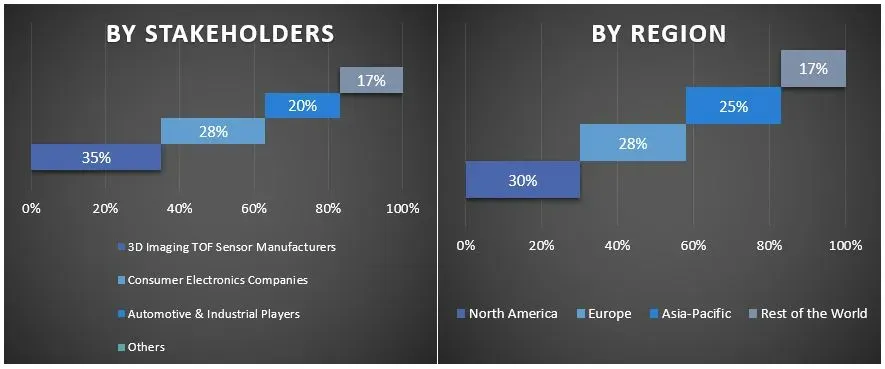
Ingegneria del mercato
La tecnica di triangolazione dei dati è stata impiegata per completare la stima complessiva del mercato e per arrivare a numeri statistici precisi per ogni segmento e sottosegmento del mercato globale dei sensori TOF per imaging 3D. I dati sono stati suddivisi in diversi segmenti e sottosegmenti dopo aver studiato vari parametri e tendenze nel tipo di prodotto, nell'applicazione, nel settore verticale e nelle regioni del mercato globale dei sensori TOF per imaging 3D.
L'obiettivo principale dello studio di mercato globale dei sensori TOF per imaging 3D
Le tendenze di mercato attuali e future del mercato globale dei sensori TOF per imaging 3D sono state individuate nello studio. Gli investitori possono ottenere informazioni strategiche per basare la propria discrezione per gli investimenti sull'analisi qualitativa e quantitativa eseguita nello studio. Le tendenze di mercato attuali e future hanno determinato l'attrattiva complessiva del mercato a livello regionale, fornendo una piattaforma per il partecipante industriale per sfruttare il mercato non sfruttato per beneficiare di un vantaggio di first-mover. Altri obiettivi quantitativi degli studi includono:
- Analizzare le dimensioni del mercato attuale e previsto del mercato dei sensori TOF per imaging 3D in termini di valore (USD). Inoltre, analizzare le dimensioni del mercato attuale e previsto di diversi segmenti e sottosegmenti.
- I segmenti nello studio includono aree di tipo di prodotto, applicazione, settore verticale e regioni.
- Definire e analizzare il quadro normativo per il sensore TOF per imaging 3D
- Analizzare la catena del valore coinvolta con la presenza di vari intermediari, insieme all'analisi dei comportamenti dei clienti e dei concorrenti del settore.
- Analizzare le dimensioni del mercato attuale e previsto del mercato dei sensori TOF per imaging 3D per le principali regioni.
- I principali Paesi delle regioni studiati nel rapporto includono Asia Pacifico, Europa, Nord America e il Resto del Mondo.
- Profili aziendali del mercato dei sensori TOF per imaging 3D e le strategie di crescita adottate dagli attori del mercato per sostenere il mercato in rapida crescita.
- Analisi approfondita a livello regionale del settore.
Domande frequenti FAQ
D1: Qual è la dimensione attuale e il potenziale di crescita del mercato dei sensori TOF per l'imaging 3D?
Il mercato dei sensori TOF per l'imaging 3D è stato valutato a 4336,02 milioni di dollari USA nel 2023 e si prevede che crescerà a un CAGR del 22,96% durante il periodo di previsione (2024-2032).
Q2: Quali sono i fattori trainanti per la crescita del mercato dei sensori TOF di imaging 3D?
Il mercato dei sensori TOF di imaging 3D è trainato principalmente dalla crescente adozione di AR/VR, riconoscimento facciale e scansione 3D nell'elettronica di consumo, insieme alla maggiore applicazione nell'automazione industriale e nella robotica.
Q3: Quale segmento detiene la quota maggiore del mercato dei sensori TOF per imaging 3D per tipo di prodotto?
Il segmento dei sensori ToF indiretti detiene la quota maggiore del mercato dei sensori TOF per imaging 3D per tipo di prodotto.
Q4: Quali sono le principali tendenze nel mercato dei sensori TOF per imaging 3D?
Il crescente sviluppo di sistemi ibridi ToF e LiDAR, lo sviluppo di sensori ToF a basso consumo energetico e l'espansione nell'imaging biomedico sono le principali tendenze nel mercato dei sensori TOF per imaging 3D.
D5: Quale regione dominerà il mercato dei sensori TOF per l'imaging 3D?
La regione del Nord America ha dominato il mercato nel 2023.
Correlati Report
I clienti che hanno acquistato questo articolo hanno acquistato anche




